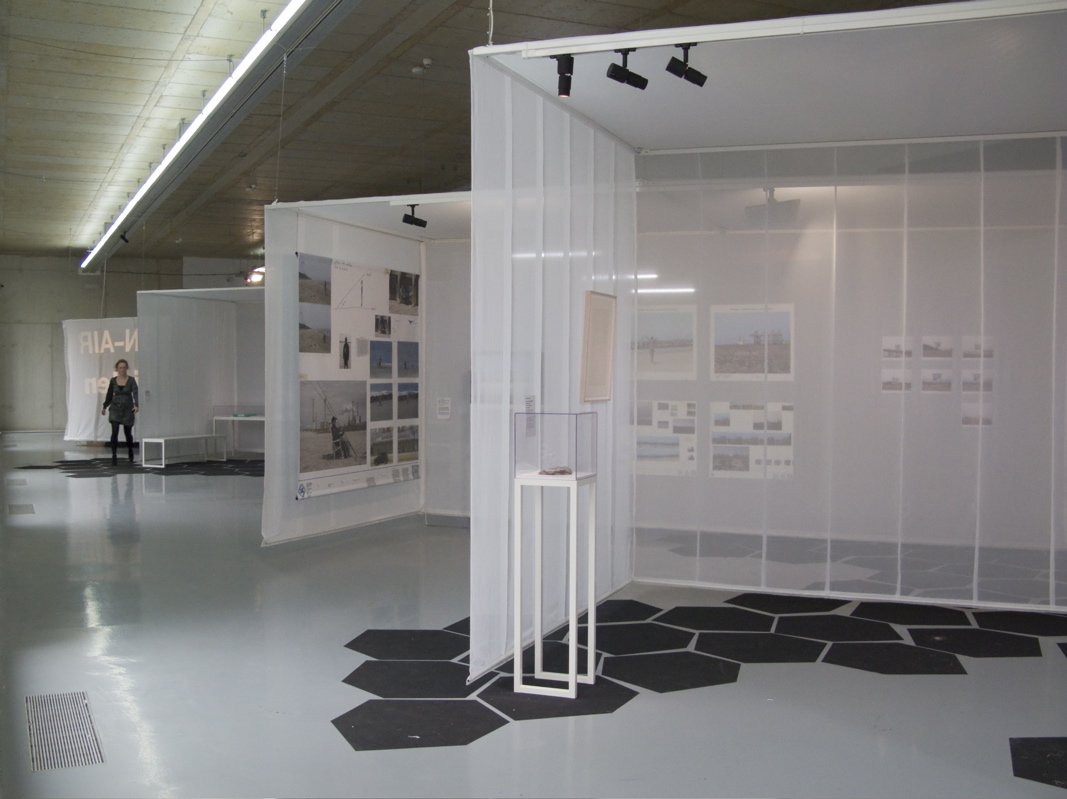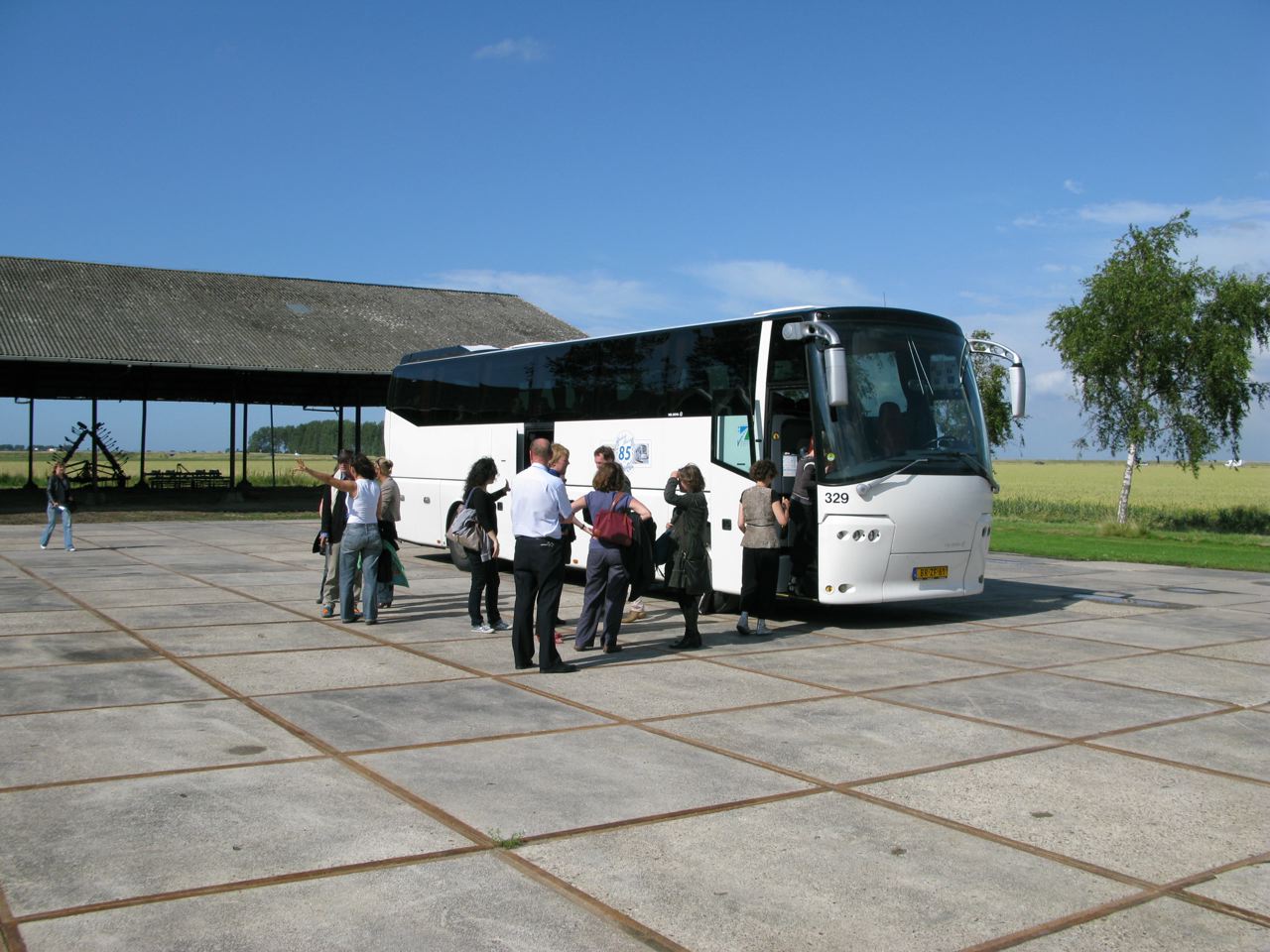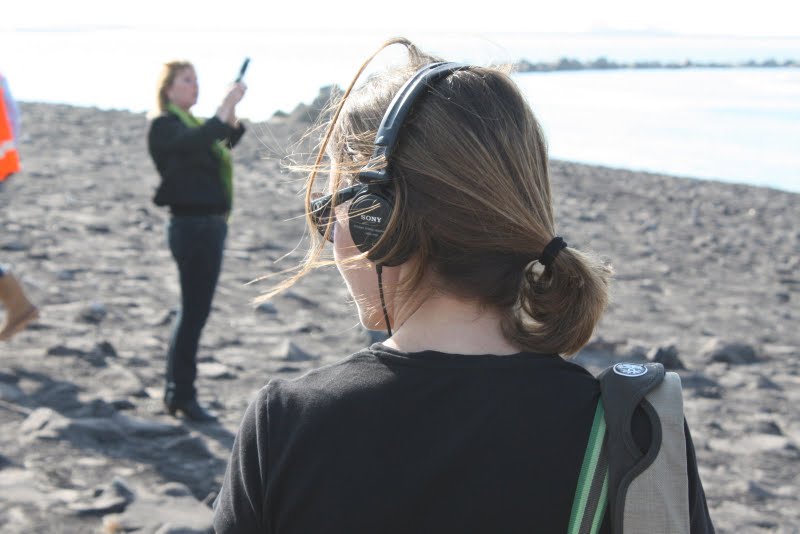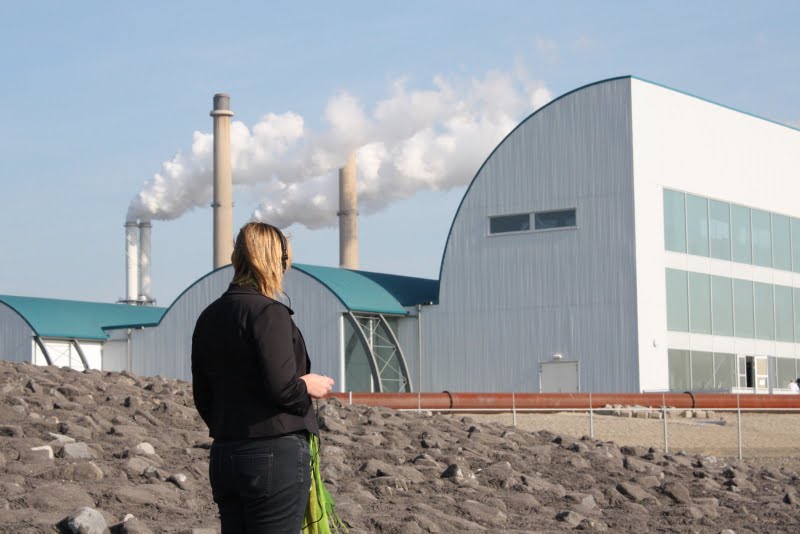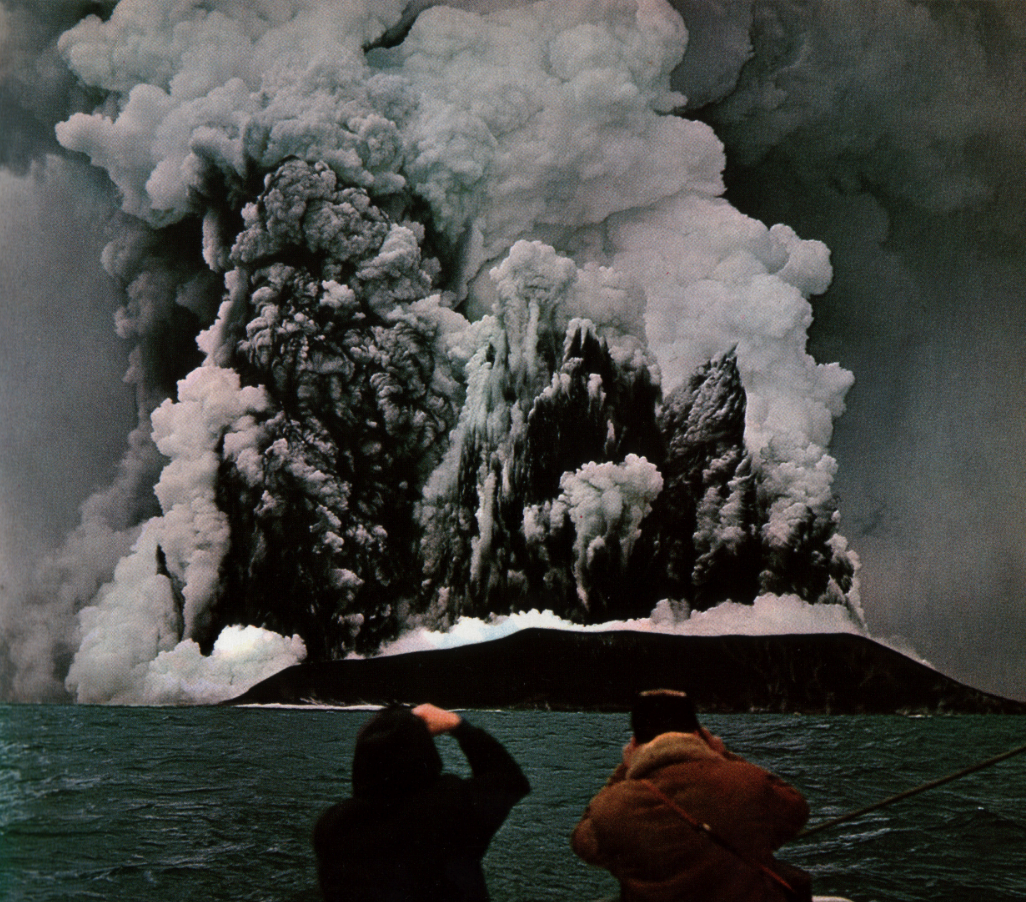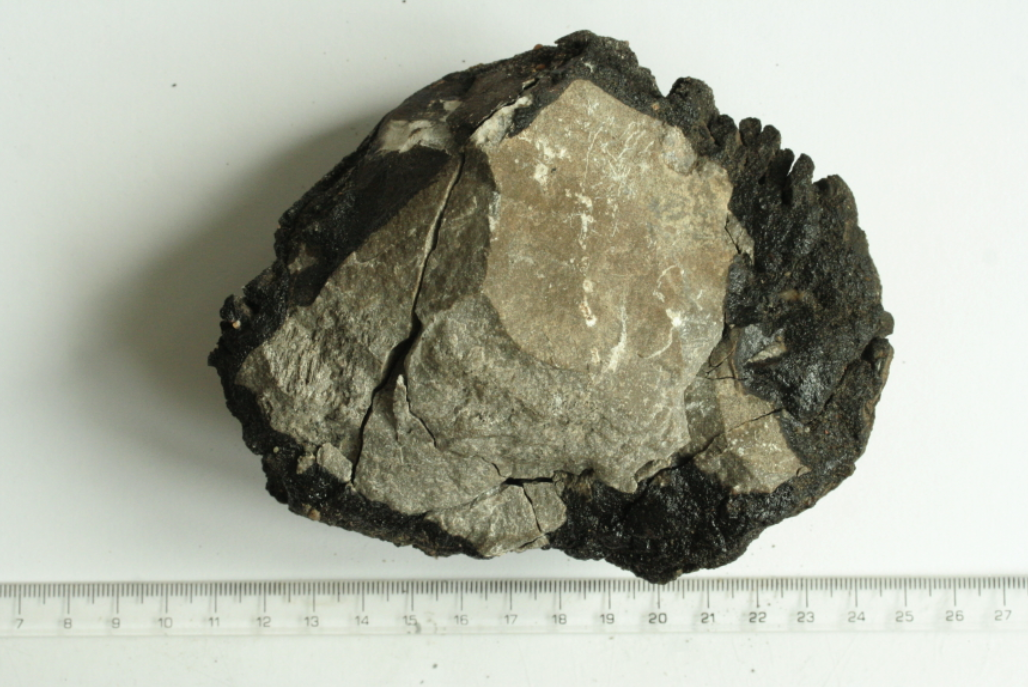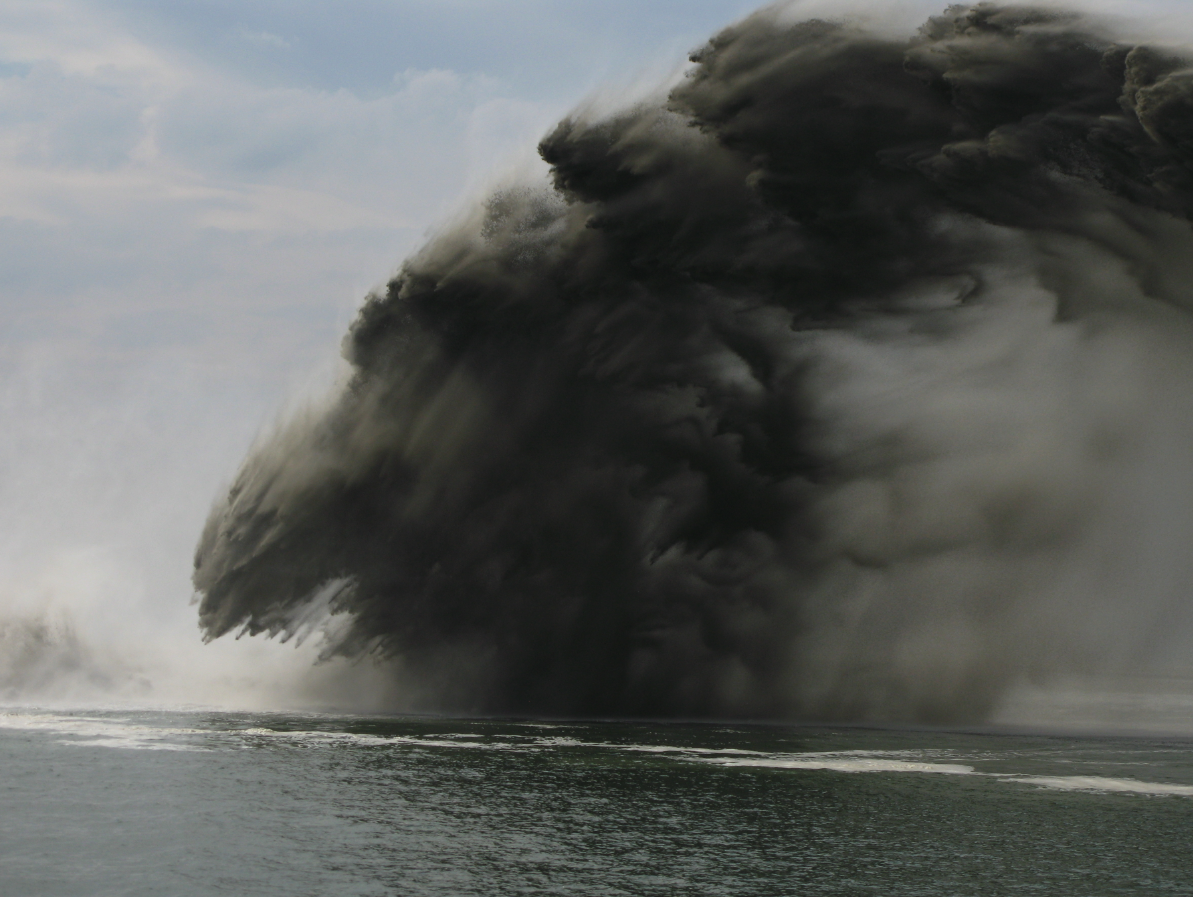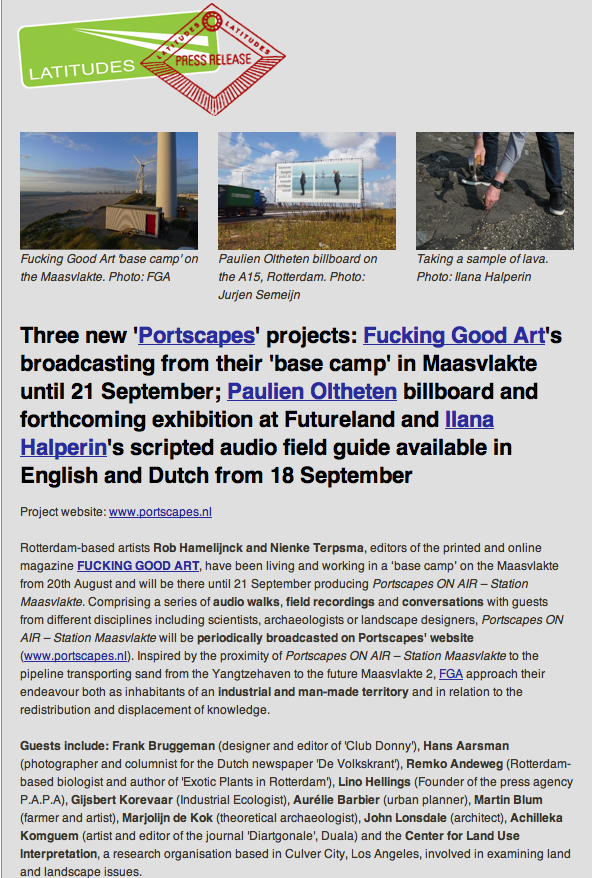Reviews of the exhibition "4.543 billion. The matter of matter" at the CAPC musée, Bordeaux
Fri, Jan 19 2018As the ‘4.543 billion. The matter of matter’ exhibition concluded on January 7, 2018, at the CAPC musée in Bordeaux, we finished archiving all the social media posts visitors, the museum and ourselves have published – see our Wakelet feed below – since research phase to the exhibition itself, and below share the most relevant print and online reviews.
December 8, 2017: Tom Jeffreys highlighted the exhibition in his "Looking Back: Paris" roundup for frieze magazine – illustrated with two works included in the show by Nicholas Mangan and Alexandra Navratil.
"A little less academic, but no less rigorous, was ‘4,543 milliards’ (4,543 billion), curated by the Barcelona-based Latitudes (co-founded by frieze contributing editor Max Andrews) at CAPC, Bordeaux. Subtitled ‘The matter of matter’, the exhibition provided a material, geological and political response to the building’s former life as a warehouse for colonial commodities and, by extension, the complex entanglement of culture, money, politics and ecological impact. Marble from Trump Tower (Amie Siegel’s "Strata", 2017) was exhibited alongside partially-burnt documents rescued from a fire at the Bordeaux municipal archives and a 1939 mock invitation to the ‘Museum of Standard Oil’, actually MoMA’s new building, issued by the then-publications director, Frances Collins (unsurprisingly fired soon after). Combining archival materials with work by 30 artists, big ideas with specificity and nuance, this was exactly the kind of exhibition I would want to return to again and again. If the selection of the next artistic director the Venice Biennale were a democratic process, I’d be voting for Latitudes."
November 28, 2017: Frank Browning, Paris-based Contributor to the Huffington Post author, and former NPR Correspondent, reviewed the recently opened retrospective of Beatriz González and concluded his article with a short mention:
"Meanwhile, around the corner at CAPC there’s an intriguing assembly of stones, papers, paintings, photographs and projections that unite geo-physics, sculpture, and art history, including the conversion of the building itself from a one-time commodities warehouse into its current life as a museum.
Entitled “The Matter of Matter,” [missing "4.543 billion" years, the age of the Earth, and the first part of the exhibition title] it includes the work of 30 artists, assembled and mounted by a Spanish team, Max Andrews and Mariana Cánepa Luna. They call themselves Latitudes [wrongly published with two "T"]; they aim to excavate the world we inhabit daily, be it through the history indigo mining in Mexico and southern France (vital for fine pottery and coloring bluejeans) or oil extraction in Venezuela, gas infused sculptures or open pit diamond mining in southern Africa. All that we do, all that we eat, all that we create derives from one form of excavation or another. Simple truism as it may seem, Latitudes takes us into the intimacies of our relation with this earth and calls us to meditate on our physical and aesthetic relation to the steadily warming round rock that is our home."
September 20, 2017: Emmanuel Labails of RCF Radio did a 9-minute interview with Pedro Jiménez Morras, Head of Press of CAPC, who discussed the premises of the exhibition and some of its works. (Listen between minute 4:39 and 13:36).
August 19, 2017: Bea Espejo's ‘Cambio de tiempo’, on the Spanish national cultural supplement Babelia, in El País newspaper begins:
˝A ese pensamiento geológico del tiempo conduce la exposición 4.543 millones. La cuestión de la materia en el CAPC de Burdeos. La muestra aborda obras de arte, colecciones e historias culturales con relación a procesos ecológicos y la escala geológica del tiempo. En total, más de 35 artistas que dan valor a las discontinuidades, a las derivas y a las ausencias. La muestra almacena el tiempo como una batería almacena la energía. Y lo hace en varias capas de lectura. Una de ellas es el tiempo que lleva Latitudes, la oficina curatorial de Mariana Cánepa Luna y Max Andrews, trabajando en este proyecto, seguramente el más complejo y ambicioso, aunque esta investigación en torno a las complejas relaciones entre la ecología y el arte contemporáneo está en la base de todos sus proyectos desde 2005. Aquí no pueden ser más rotundos. Abordan la cuestión de la materia desde el lado más inmaterial, que es la memoria. Para ello, estudiaron a fondo el contexto de la ciudad bajo un programa de residencias del museo. Hablamos, pues, de un proyecto de investigación, algo que se traduce en cada pequeño gesto que recoge la muestra, y que lo expande todo. De ahí las relaciones de algunas obras con el departamento de zoología de la universidad (Ilana Halperin), el Museo de Bellas Artes (Stuart Whipps, o el préstamo de Alfred Roll), así como los muchos documentos y objetos que se incluyen de los archivos Métropole, de la Gironde y la colección geológica de la UFR Sciences de la Terre et de la Mer, de la Universidad de Burdeos.˝
July 12, 2017: Catherine Darfay's ‘Le CAPC remonte le temps’ on the local newspaper "Sudouest", was the first feature. The article was illustrated with a with an image showing Amy Balkin's ‘Today’s CO2 Spot Price’ (2009) chartering the daily price of carbon dioxide emissions allowances in the world’s largest carbon market —a changing value documented in this blog post.
RELATED CONTENT:
2017, 4543 billion, Alexandra Navratil, amie siegel, Amy Balkin, CAPC Bordeaux, cover story, Frieze, Ilana Halperin, Latitudes-curated, Nicholas Mangan, press coverage, reseña, Reviews, Stuart Whipps, Wakelet
Wakelet collection of the "4.543 billion" exhibition.
December 8, 2017: Tom Jeffreys highlighted the exhibition in his "Looking Back: Paris" roundup for frieze magazine – illustrated with two works included in the show by Nicholas Mangan and Alexandra Navratil.
"A little less academic, but no less rigorous, was ‘4,543 milliards’ (4,543 billion), curated by the Barcelona-based Latitudes (co-founded by frieze contributing editor Max Andrews) at CAPC, Bordeaux. Subtitled ‘The matter of matter’, the exhibition provided a material, geological and political response to the building’s former life as a warehouse for colonial commodities and, by extension, the complex entanglement of culture, money, politics and ecological impact. Marble from Trump Tower (Amie Siegel’s "Strata", 2017) was exhibited alongside partially-burnt documents rescued from a fire at the Bordeaux municipal archives and a 1939 mock invitation to the ‘Museum of Standard Oil’, actually MoMA’s new building, issued by the then-publications director, Frances Collins (unsurprisingly fired soon after). Combining archival materials with work by 30 artists, big ideas with specificity and nuance, this was exactly the kind of exhibition I would want to return to again and again. If the selection of the next artistic director the Venice Biennale were a democratic process, I’d be voting for Latitudes."
November 28, 2017: Frank Browning, Paris-based Contributor to the Huffington Post author, and former NPR Correspondent, reviewed the recently opened retrospective of Beatriz González and concluded his article with a short mention:
"Meanwhile, around the corner at CAPC there’s an intriguing assembly of stones, papers, paintings, photographs and projections that unite geo-physics, sculpture, and art history, including the conversion of the building itself from a one-time commodities warehouse into its current life as a museum.
Entitled “The Matter of Matter,” [missing "4.543 billion" years, the age of the Earth, and the first part of the exhibition title] it includes the work of 30 artists, assembled and mounted by a Spanish team, Max Andrews and Mariana Cánepa Luna. They call themselves Latitudes [wrongly published with two "T"]; they aim to excavate the world we inhabit daily, be it through the history indigo mining in Mexico and southern France (vital for fine pottery and coloring bluejeans) or oil extraction in Venezuela, gas infused sculptures or open pit diamond mining in southern Africa. All that we do, all that we eat, all that we create derives from one form of excavation or another. Simple truism as it may seem, Latitudes takes us into the intimacies of our relation with this earth and calls us to meditate on our physical and aesthetic relation to the steadily warming round rock that is our home."
September 20, 2017: Emmanuel Labails of RCF Radio did a 9-minute interview with Pedro Jiménez Morras, Head of Press of CAPC, who discussed the premises of the exhibition and some of its works. (Listen between minute 4:39 and 13:36).
August 19, 2017: Bea Espejo's ‘Cambio de tiempo’, on the Spanish national cultural supplement Babelia, in El País newspaper begins:
˝A ese pensamiento geológico del tiempo conduce la exposición 4.543 millones. La cuestión de la materia en el CAPC de Burdeos. La muestra aborda obras de arte, colecciones e historias culturales con relación a procesos ecológicos y la escala geológica del tiempo. En total, más de 35 artistas que dan valor a las discontinuidades, a las derivas y a las ausencias. La muestra almacena el tiempo como una batería almacena la energía. Y lo hace en varias capas de lectura. Una de ellas es el tiempo que lleva Latitudes, la oficina curatorial de Mariana Cánepa Luna y Max Andrews, trabajando en este proyecto, seguramente el más complejo y ambicioso, aunque esta investigación en torno a las complejas relaciones entre la ecología y el arte contemporáneo está en la base de todos sus proyectos desde 2005. Aquí no pueden ser más rotundos. Abordan la cuestión de la materia desde el lado más inmaterial, que es la memoria. Para ello, estudiaron a fondo el contexto de la ciudad bajo un programa de residencias del museo. Hablamos, pues, de un proyecto de investigación, algo que se traduce en cada pequeño gesto que recoge la muestra, y que lo expande todo. De ahí las relaciones de algunas obras con el departamento de zoología de la universidad (Ilana Halperin), el Museo de Bellas Artes (Stuart Whipps, o el préstamo de Alfred Roll), así como los muchos documentos y objetos que se incluyen de los archivos Métropole, de la Gironde y la colección geológica de la UFR Sciences de la Terre et de la Mer, de la Universidad de Burdeos.˝
July 12, 2017: Catherine Darfay's ‘Le CAPC remonte le temps’ on the local newspaper "Sudouest", was the first feature. The article was illustrated with a with an image showing Amy Balkin's ‘Today’s CO2 Spot Price’ (2009) chartering the daily price of carbon dioxide emissions allowances in the world’s largest carbon market —a changing value documented in this blog post.
RELATED CONTENT:
- “4.543 billion. The Matter of Matter” exhibition
- Archive of social networks posts related to "4.543 billion"
- Photo gallery of the exhibition
- CAPC website (French, English, Spanish) http://www.capc-bordeaux.fr/programme/4543-milliards
- Cover Story—December 2017: "Tabet's Tapline trajectory" 4 December 2017
- Alfred Roll's 1878 "The Old Quarryman" exchanged with Alfred Smith's "The Grave Docks" (1884) in the exhibition "4.543 billion" at the CAPC musée 3 November 2017
- Cover Story—November 2017: "Mining negative monuments: Ângela Ferreira, Stone Free, and The Return of the Earth" 1 November 2017
- 15 November 2017, 4:30–8pm: 'The Return of the Earth. Ecologising art history in the Anthropocene' study day at the CAPC musée, Bordeaux 24 October 201
- Cover Story – July 2017: 4.543 billion 3 July 2017
- Cover Story – May 2017: S is for Shale, or Stuart; W is for Waterfall, or Whipps 1 May 2017
- SAVE THE DATE: 29 June, 19h. Private view of the exhibition "4.543 billion. The matter of matter" at the CAPC musée d'art contemporain de Bordeaux 30 May 2017
- Cover Story – May 2016: Material histories – spilling the beans at the CAPC musée d’art contemporain de Bordeaux 10 May 2016.
- Second research trip to Bordeaux 16 July 2016
Public programme of the exhibition "4.543 billion. The Matter of Matter" at the CAPC musée d'art contemporain de Bordeaux
Wed, Dec 6 2017 |
| First public event on 30 June to the Salle des Collections de l'Unité de Formation de Biologie, Université de Bordeaux. This and following photos: Latitudes. |
On December 14 at 2pm, the mediation department of the CAPC will lead a guided visit to Ilana Halperin’s "The Rock Cycle" (2017) intervention at the Salle des Collections de l'Unité de Formation de Biologie, Université de Bordeaux.
The event is the third visit (earlier ones took place on October 19 and November 16) programmed in the context of her participation in the exhibition ‘4.543 billion. The matter of matter’ on view at the CAPC musée d'art contemporain de Bordeaux. The next (and final one) will be taking place on January 4, three days before the exhibition closes on January 7, 2018.
These events are free. Booking is recommended via Léo Correa l.correa@mairie-bordeaux.fr T. (+33) 05 56 00 81 60.
Ilana Halperin’s new project for the exhibition '4.543 billion' deals with geological intimacy and vivacity, and the uncanny fact that something as apparently inert and certain as the stone walls of the CAPC building were once marine life from a tropical ocean of the Oligocene epoch, around 32 million-years-ago. This Calcaire à Astéries (asteriated limestone) characteristic of Bordeaux takes its name from the countless tiny fossil organisms of the genus asterias (a type of sea star) that can be found in the stone alongside fossil mollusks and coral.
Halperin addresses stone, not as dead matter or a mere resource, but as a story-laden substance that both surpasses and partners in humans’ view of the world. 'The Rock Cycle' incorporates the reading of a letter and the hosting of a number of the artist’s geological sculptures within the displays of the zoology collection of the University of Bordeaux. These ‘curios’ originated as fragments of sea-weathered brick from the Isle of Bute in western Scotland, as well as waterjet-cut sandstone, that the artist left for three months in Fontaines Pétrifiantes in Saint-Nectaire. For generations, the mineral-rich waters that percolate through the rock at this site in central France have been used to create sculptures using the same process by which stalactites form, only one hundred times faster. Objects become rapidly encrusted with new layers of stone.
—Latitudes
[Excerpt from the exhibition guide]
Three other events have been programmed in the context of the exhibition.
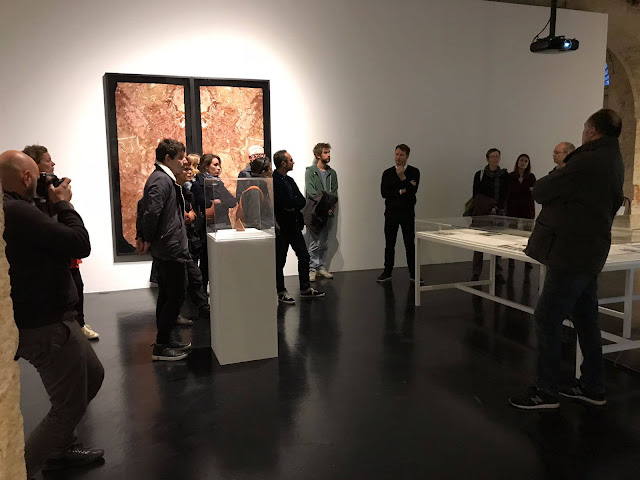 | |
| Visit with Terence Gower (participating artist) and Prof. Bruno Cahuzac. Photo: CAPC musée/Département des publics. |
8 November 2017, 5:30–7pm
Jam Session #1—Guided tour by Terence Gower (participating artist) and Prof. Bruno Cahuzac (UFR Sciences de la Terre et de la Mer, Université de Bordeaux Montaigne).
 |
| Guests during “The Return of the Earth: Ecologising art history in the Anthropocene” event. Photo: Latitudes. |
15 November 2017, 4:30–8pm
“The Return of the Earth: Ecologising art history in the Anthropocene”—Lecture by Jean-Baptiste Fressoz, a conversation between Xavier Ribas and Ângela Ferreira, debate convened by Latitudes. Free access. Simultaneous translation English-French.
 |
| During Jam Session #2 event. Photo: CAPC musée/Département des publics. |
6 December 2017, 5:30–7pm
Jam Session #2—Guided tour by Isabelle Kanor (Head association "Le Labo de Lettres” dealing with cultural issues in the Antilles and colonization), and Charlotte Bouvier and Rémi Cazamajour (Inélia, company that supplied the solar panels feeding the video installation "Ancient Lights" (2015) by Nicholas Mangan). Sign up: Stéphane Mallet, s.mallet@mairie-bordeaux.fr
 | ||||||||||||||
| Photo: Latitudes/RK. |
The exhibition ‘4.543 billion’ is the contribution of the CAPC musée to the cultural season Paysages Bordeaux 2017. Between September 11–October 6, 2017, and within the exhibition framework, Latitudes led the month-long residency programme ‘Geologic Time’ at Banff Centre for Arts and Creativity, Alberta, Canada.
Share:
#4543billion
#4543milliards
#CAPCmusee
RELATED CONTENT:
- “4.543 billion. The Matter of Matter” exhibition
- Archive of social networks posts related to "4.543 billion"
- Photo gallery of the exhibition
- CAPC website (French, English, Spanish) http://www.capc-bordeaux.fr/programme/4543-milliards
- Cover Story—December 2017: "Tabet's Tapline trajectory" 4 December 2017
- Alfred Roll's 1878 "The Old Quarryman" exchanged with Alfred Smith's "The Grave Docks" (1884) in the exhibition "4.543 billion" at the CAPC musée 3 November 2017
- Cover Story—November 2017: "Mining negative monuments: Ângela Ferreira, Stone Free, and The Return of the Earth" 1 November 2017
- 15 November 2017, 4:30–8pm: 'The Return of the Earth. Ecologising art history in the Anthropocene' study day at the CAPC musée, Bordeaux 24 October 201
- Cover Story – July 2017: 4.543 billion 3 July 2017
- Cover Story – May 2017: S is for Shale or Stuart; W is for Waterfall, or Whipps 1 May 2017
- SAVE THE DATE: 29 June, 19h. Private view of the exhibition "4.543 billion. The matter of matter" at the CAPC musée d'art contemporain de Bordeaux 30 May 2017
- Cover Story – May 2016: Material histories – spilling the beans at the CAPC musée d’art contemporain de Bordeaux 10 May 2016.
- Second research trip to Bordeaux 16 July 2016
Installation views of the 'Portscapes' exhibition, Museum Boijmans Van Beuningen, Rotterdam, on view until 25 April. Free entrance.
Sun, Feb 14 2010
View of the outside of the Richard Serra Hall / Museum Boijmans Van Beuningen
Exhibition of the documentation material produced during the year-long commissioning series of works in and around Rotterdam's port extension project Maasvlakte 2, with works by Lara Almarcegui, Bik van der Pol, Jan Dibbets,Marjolijn Dijkman, Fucking Good Art, Ilana Halperin, Christina Hemauer & Roman Keller,Paulien Oltheten, Jorge Satorre, and Hans Schabus (website collaborators: Maria Barnas (poetry) and Markus Miessen (interviews)).
More images of the exhibition here.
More images of each commission here.
'Making of' videos here.
Museum Boijmans Van Beuningen, Museumpark 18-20, 3015 CX Rotterdam, The Netherlands
Opening hours: Tue–Sun 11.00 to 17.00
Opening hours: Tue–Sun 11.00 to 17.00
All images: Latitudes | www.lttds.org
'Portscapes' "making of" videos on Latitudes' YouTube Channel
Fri, Feb 12 2010Latitudes' YouTube Channel also includes documentation of an action with Lawrence Weiner in the context of his 2008 Fundació Suñol exhibition 'THE CREST OF A WAVE' as well as Ignasi Aballí whitewashing a window for his exhibition 'Something, or nothing' in the Suitcase Art Projects, Beijing.
Portscapes bus tour: Lara Almarcegui wasteland tour and Christina Hemauer & Roman Keller's 'Postpetrolistic Internationale' choir performance
Tue, Nov 10 2009On Sunday 8 November 2009, SKOR and the Port of Rotterdam Authority organised a bus tour around the Port of Rotterdam coinciding with the 4th International Architecture Biennial Rotterdam and the culmination of 'Portscapes' projects, a year-long series of commissions in and around Maasvlakte 2, the 2,000 hectare ongoing extension of the port.
Over 80 visitors enjoyed the 'The Postpetrolistic Internationale' choir performance, a project by the Zurich-based artists Roman Keller & Christina Hemauer as well as the tour around four wasteland sites included in the research publication of the guide 'Wastelands of the Port of Rotterdam' by Rotterdam-based artist Lara Almarcegui.
During the tour, visitors were also able to see and listen to other 'Portscapes' projects by Marjolijn Dijkman, Fucking Good Art, Ilana Halperin (audio here), Jorge Satorre, Hans Schabus and Paulien Oltheten.
An exhibition of the projects will take place at the Museum Boijmans van Beuningen from 5 February, coinciding with Art Rotterdam. Exhibition on view until end of March 2010.
Portscapes is a series of newly commissioned art projects initiated by the Port of Rotterdam Authority on occasion of the construction of Maasvlakte 2, with advice and support from SKOR (Foundation for Art and Public Space, Amsterdam) and is curated by Latitudes (Barcelona).
Roman Keller and Christina Hemauer's participation has been made possible thanks to the support of Pro Helvetia.
'Portscapes' news: Bus Tour around the Port of Rotterdam, Sunday 8 November 2009, 10–15h
Sun, Oct 25 2009–ENG–
Bus Tour – Portscapes public art projects on the Maasvlakte, Rotterdam.
SKOR invited the duo Latitudes from Barcelona, who has curated a series of projects reflecting on the architectural, political, social and ecological aspects of the past, present and future of the Rotterdam port with a focus on the new Maasvlakte 2. Portscapes consists of ten new commissions in and about the Maasvlakte by Dutch and international artists, including interventions, films, performances and mobile seminars.
Bus tour bookings: write to ad [at] skor.nl by 2 November 2009
Free tour. English spoken
An exhibition of the Portscapes projects will be on show at the Museum Boijmans van Beuningen in Rotterdam from 5 February, until late March 2010.
Programme on 8 November
(Programme subject to changes)
9.45 am – Leave from NAI Rotterdam, Museumpark 25 3015 CB, Rotterdam
On the way to the port you can listen to interviews by Fucking Good Art on mp3 players in the bus. Amongst others, Hans Aarsman, an industrial ecologist, a botanist and an archaeologist, will describe his vision of the Maasvlakte on the basis of his field of expertise. The artistic duo FGA broadcast this and other conversations from a temporary web radio station in a container united placed on the Maasvlakte between 21 August and 21 September.
10.45 am – Visit to wastelands by artist Lara Almarcegui and botanist Remko Andeweg
The Spanish-born Rotterdam-based artist Lara Almarcegui has published a free newspaper research project concerning the ‘wasteland’ areas which can be encountered throughout the Port of Rotterdam. Almarcegui and botanist Remko Andeweg will describe these areas characterised by an apparent lack of human intervention.
12.00 am – Arrival at Futureland, the Maasvlakte information centre
On the way we pass the billboards by the artists Marjolijn Dijkman, Jorge Satorre, Paulien Oltheten and Hans Schabus.
Lunch in Futureland, provided by the Rotterdam Port Authority.
Introduction by Latitudes, curators of 'Portscapes'
1.00 pm – Tour of the artworks in and around Futureland
You can view work by Paulien Oltheten and Hans Schabus and explore the nearby area picking up Ilana Halperin’s audio tour. Halperin created a compelling narrative of fragments which draws on fact, fiction and personal fieldwork – as well as site surveys by volcanologists, geologists and the experts involved in the construction of Maasvlakte 2.
1.30 pm – Performance 'Postpetrolistic Internationale'
The project by Swiss artists Roman Keller & Christina Hemauer emerges from the medium of the collective human voice, the tradition of the aspirational social anthem alongside the artists’ long standing interest in energy use. The project starts with the transportation of a wooden stage along the Rhine from Basel (where the Rhine begins), near the artists’ home, to Rotterdam (where the Rhine joins the sea) – see post 30.10.09. Upon arrival a local choir will perform this anthem of hope-in-action (composed by the artists in collaboration with musician Mathias Vette) on the stage, against a backdrop of local industry, to mark man’s changing relationship with fossil fuels and energy use.
2 pm – Return to NAI Rotterdam with a number of stops at various art projects along the way: wastelands by Lara Almarcegui and works by Paulien Oltheten
3 pm – Arrival in NAI Rotterdam. End of the journey.
Portscapes is commissioned by the Port of Rotterdam Authority with advice from SKOR (Foundation for Art and Public Space, Amterdam) and is curated by Latitudes.
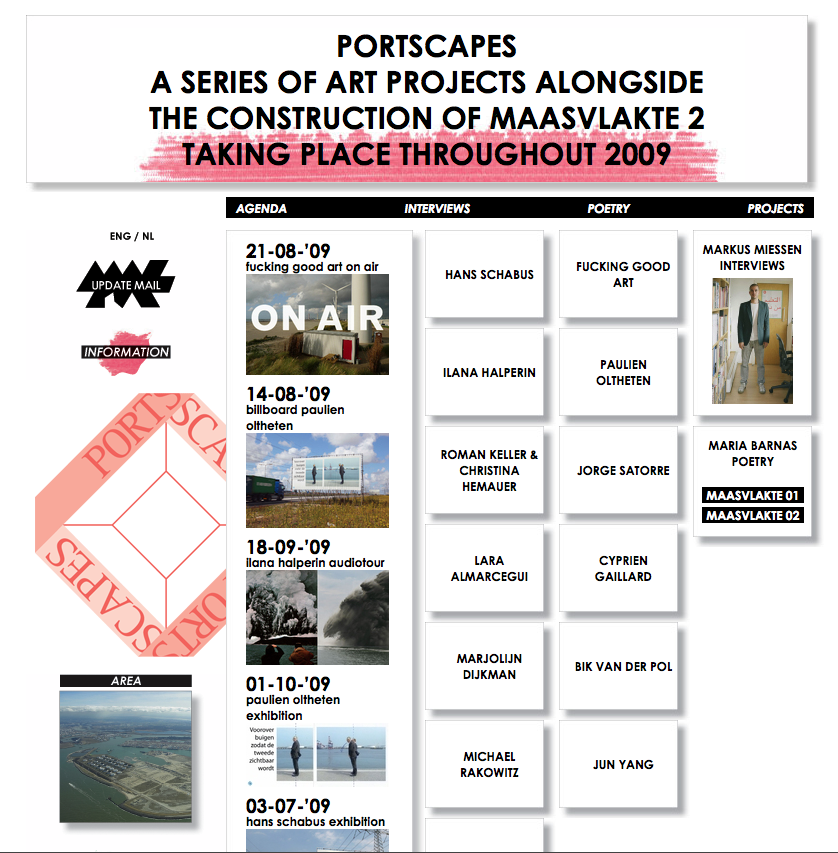
–CAST–
Bus tour dirección al puerto de Rotterdam, Domingo 8 Noviembre 2009, 10–15h, organizado por SKOR y la Autoridad Portuaria de Rotterdam coincidiendo con la 4th International Architecture Biennial Rotterdam. Tour organizado en ocasión de Portscapes, la serie acumulativa de proyectos públicos que en el Puerto de Rotterdam
Presentación de dos nuevos proyectos: performance de los suizos Roman Keller y Christina Hemauer (7–8 Noviembre) y publicación de la guía 'Wastelands of the Port of Rotterdam' realizada por Lara Almarcegui. Durante el tour se podrán ver y escuchar los proyectos realizados por Marjolijn Dijkman, Fucking Good Art, Ilana Halperin, Jorge Satorre, Hans Schabus y Paulien Oltheten.
Para reservar tu plaza, escribe a ad@skor.nl antes del 2 November 2009.
Accesso gratuito, tour será en inglés.
Exposición de los proyectos de Portscapes tendrá lugar en el Museum Boijmans van Beuningen, Rotterdam, a partir del 5 de Febrero y hasta finales de Marzo 2010.
PROGRAMA 8 NOVIEMBRE
9.45-15hs
(Programa sujeto a cambios de última hora)
09.45 am – Salida desde NAI Rotterdam, Museumpark 25 3015 CB, Rotterdam
Durante el recorrido se podrá escuchar mediante auriculares una entrevista al ecologista, botanista, y arqueólogo Hans Aarsman realizada por el duo FGA durante su residencia en un container emplazado en el Maasvlakte, desde donde recogieron conversaciones temáticas y exploraciones de campo. + info...
Durante el recorrido se podrá escuchar mediante auriculares una entrevista al ecologista, botanista, y arqueólogo Hans Aarsman realizada por el duo FGA durante su residencia en un container emplazado en el Maasvlakte, desde donde recogieron conversaciones temáticas y exploraciones de campo. + info...
10.45 am –
Visita de terrenos baldíos por Lara Almarcegui y el botanista Remko Andeweg.
La artista española afincada en Rotterdam Lara Almarcegui ha publicado una guía en formato periódico en la que se recoge su investigación entorno a los actuales terrenos baldíos que pueden encontrarse a lo largo de puerto de Rotterdam. En contraste con la gran planificación que circunda el futuro Maasvlakte 2, Almarcegui se interesa por los espacios definidos por la aparente falta de diseño y desarrollo. El público navegará el puerto como un territorio interconectado con la ayuda de esta guía que, como ha manifestado la artista, "actuará como una herramienta para conocerlo mejor (...) para ver cómo el territorio está cambiando. En el futuro, cuando la mayoría de estos terrenos se vean modificados, la guía actuará como un documento histórico que describirá cómo fue el puerto en el 2009".
12.00 am – Visita del centro de visitantes Futureland y almuerzo
Durante el viaje se podrán ver las vallas publicitarias de los artistas Marjolijn Dijkman, Jorge Satorre, Paulien Oltheten y Hans Schabus. A la llegada Latitudes, comisarios de 'Portscapes', introducirán los proyectos.
Durante el viaje se podrán ver las vallas publicitarias de los artistas Marjolijn Dijkman, Jorge Satorre, Paulien Oltheten y Hans Schabus. A la llegada Latitudes, comisarios de 'Portscapes', introducirán los proyectos.
1.00 pm – Visita de las obras presentadas en Futureland y alrededores
Visita de las obras de Paulien Oltheten y Hans Schabus así como la audioguía 'A Brief History of Mobile Landmass' realizada por Ilana Halperin. La audioguía narra fragmentos reales y ficticios recogidos a partir de la investigación de la artista y expertos entorno a volcanes y estudios de campo relacionados con la presente construcción del Maasvlakte 2 – escuchar capítulos o descargar archivos aquí
Visita de las obras de Paulien Oltheten y Hans Schabus así como la audioguía 'A Brief History of Mobile Landmass' realizada por Ilana Halperin. La audioguía narra fragmentos reales y ficticios recogidos a partir de la investigación de la artista y expertos entorno a volcanes y estudios de campo relacionados con la presente construcción del Maasvlakte 2 – escuchar capítulos o descargar archivos aquí
13.30h – '
Postpetrolistic Internationale', performance de Roman Keller & Christina Hemauer
El proyecto de los suizos Roman Keller & Christina Hemauer comienza con el transporte de un escenario a lo largo del Rin, desde Basilea (donde el Rin abandona Suiza) y cerca de donde viven los artistas, hasta Rotterdam (donde el Rin desemboca en el mar) - léase post 30.10.09. A su llegada un coro cantará la 'The Postpetrolistic Internationale', un himno social compuesto por los artistas en colaboración con el músico y compositor Mathias Vetter, que proclama el comienzo de una nueva era donde el petróleo pertenece al pasado. Los días 7 y 8 de noviembre un coro local interpretará este himno de esperanza sobre el escenario en pleno paisaje industrial, para poner en perspectiva la historia evolución de hombre y su relación con los combustibles fósiles y el uso de la energía. Ésta será la primera vez que se cantará en inglés.
2 pm – Regreso al NAI Rotterdam con varias paradas durante el recorrido a los terrenos valdíos seleccionados por Lara Almarcegui y obras de Paulien Oltheten
Portscapes es un encargo de la Autoridad Portuaria de Rotterdam con el consejo de SKOR (Foundation for Art and Public Space, Amsterdam) y comisariado por Latitudes.
Portscapes News: Launch of Ilana Halperin's 45 min-long audio field guide ‘A Brief History of Mobile Landmass’
Fri, Sep 18 2009The two first images are courtesy of Ben Wind, rest of images courtesy of the artist.
As her contribution to ‘Portscapes’, New York-born Glasgow-based artist Ilana Halperin has created a spoken-word narrative in Dutch and English for visitors to the port. Available at the visitor centre Futureland (map here) and online (www.portscapes.nl) from September 18 until 2013, ‘A Brief History of Mobile Landmass’ is an audio field guide inspired by a perception of Maasvlakte 2 in terms of formidable geophysical phenomena and a geological sense of time.
The artist has assembled a compelling narrative of fragments which draws on fact, fiction and personal fieldwork – as well as site surveys by volcanologists, geologists and the experts involved in the construction of Maasvlakte 2. It offers echoes, speculations and interpretations surrounding both the artificial and natural processes whereby new land is created. Recalling Jules Verne’s ‘Voyages Extraordinaires’, this 'book on tape' couples a wealth of scientific information with wonder and vivid descriptions.
Halperin is your guide through a landscape with tales of newborn islands, otherworldly Hawaiian magma and the fire deity Pele, a Rotterdam ‘lava flow’ or the ‘industrial volcanoes’ of its port. To paraphrase Mark Twain’s astonished account of the eruption of Kilauea in 1866: “Here is room for the imagination to work!”.
'Portscapes' is an accumulative series of newly commissioned projects taking place throughout 2009 alongside the construction of Rotterdam's [51° 55' N 4° 29' E] Maasvlakte 2 (MV2) – an extension to Europe's largest seaport and industrial area which will be realised between 2008 and 2013 by reclaiming a 2,000-hectare area of reclaimed land (see images here) that will extend the Port of Rotterdam, Europe's largest seaport and industrial area by 20%.
Portscapes is commissioned by the Port of Rotterdam Authority with advice and support from SKOR (Foundation for Art and Public Space, Amsterdam) and is curated by the Barcelona-based curatorial office Latitudes.
Three new 'Portscapes' projects: Fucking Good Art, Paulien Oltheten and Ilana Halperin
Mon, Sep 14 2009Three new 'Portscapes' projects: Fucking Good Art's broadcasting from their 'base camp' in Maasvlakte until 21 September; Paulien Oltheten billboard and forthcoming exhibition at Futureland and Ilana Halperin's scripted audio field guide available in English and Dutch from 18 September 2009
Project website: www.portscapes.nl
More info on this projects here
Rotterdam-based artists Rob Hamelijnck and Nienke Terpsma, editors of the printed and online magazine FUCKING GOOD ART, have been living and working in a ‘base camp’ on the Maasvlakte from 20th August and will be there until end of September producing Portscapes ON AIR – Station Maasvlakte. (+ info...)
On 14 August 2009 a billboard by Amsterdam-based artist PAULIEN OLTHETEN was placed along the A15 on the Maasvlakte. Oltheten made use of the lack of reference of natural elements, such as trees, bushes and people by arranging meetings. These stagings mostly take place in locations on the Maasvlakte that will soon disappear or be displaced and often involve variations of the theme ‘one becomes two’, referring to the Maasvlakte, of which there will later be two. (+ info...)
As her contribution to Portscapes, New York-born Glasgow-based artist ILANA HALPERIN has created an audio field guide available online and on MP3 players which visitors will be able to pick up at Futureland (map here) and experience through wandering the nearby area of the port edge. ‘A Brief History of Mobile Landmass’ is inspired by a perception of Maasvlakte 2 in terms of formidable geophysical phenomena and a geological sense of time. (+ info...)
Audioguide available online and at Futureland (map here) from 18 September 2009 until 2013. Narrated in English and Dutch. Duration: 45 min.
–
'Portscapes' is an accumulative series of art commissions taking place throughout 2009 alongside the construction of ‘Maasvlakte 2’, a 2,000 hectare area of reclaimed land that will extend the Port of Rotterdam, Europe's largest seaport and industrial area by 20%. Projects varied in size and scale will be produced under the leitmotif itineraries and destinations comprising tours, audioguides, performances, radio programmes, interventions, for example. (+ info...)
Artists involved in Portscapes: Lara Almarcegui, Bik van der Pol, Jan Dibbets, Marjolijn Dijkman, Fucking Good Art, Cyprien Gaillard, Ilana Halperin, Roman Keller & Christina Hemauer, Paulien Oltheten, Michael Rakowitz, Jorge Satorre, Hans Schabus and Jun Yang. Website collaborators: Maria Barnas (poetry) and Markus Miessen (interviews).
Read more on completed projects and on projects in production.
'Portscapes' press coverage here. To receive Portscapes news sign up here.
'Portscapes' is commissioned by the Port of Rotterdam Authority with advice and support from SKOR (Foundation for Art and Public Space) and is curated by Latitudes.
Newsletter #15, September 2009
Tue, Sep 1 2009We have just circulated our September 2009, you may read English version or Versión española. This September we are presenting a three more Portscapes projects (see previous presentations of Hans Schabus and Jan Dibbets) by Rotterdam-based magazine editors Fucking Good Art (http://www.fuckinggoodart.nl), Amsterdam-based Paulien Oltheten and Glasgow-based Ilana Halperin. Read about projects in development here.
On the 25, 26 and 27 September Latitudes will be participating in the second part of 'Produce, Exhibit and Interpret (Strategies and conflicts in today's curatorial practice)' in Matadero Madrid, a meeting of generationally-linked contemporary art Spanish-based curators designed to generate and strengthen social networks among professionals from the sector.
If you would like to subscribe to our mailing list please fill your data on this contact form (see left) - please choose ONE language only. If you would like to read previous newsletters, click here.
Check also Latitudes's blog at www.lttds.org/blog for further news.

















